Green Building Materials Market Size
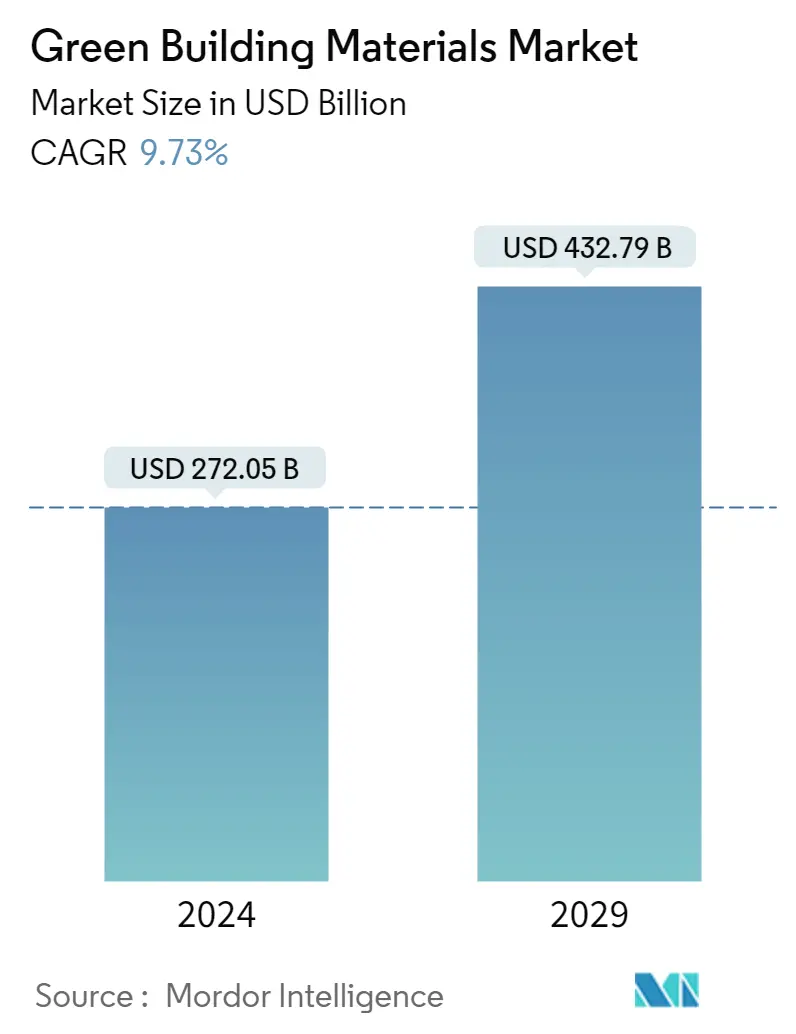
| Study Period | 2019 - 2029 |
| Market Size (2024) | USD 272.05 Billion |
| Market Size (2029) | USD 432.79 Billion |
| CAGR (2024 - 2029) | 9.73 % |
| Fastest Growing Market | Asia-Pacific |
| Largest Market | North America |
Major Players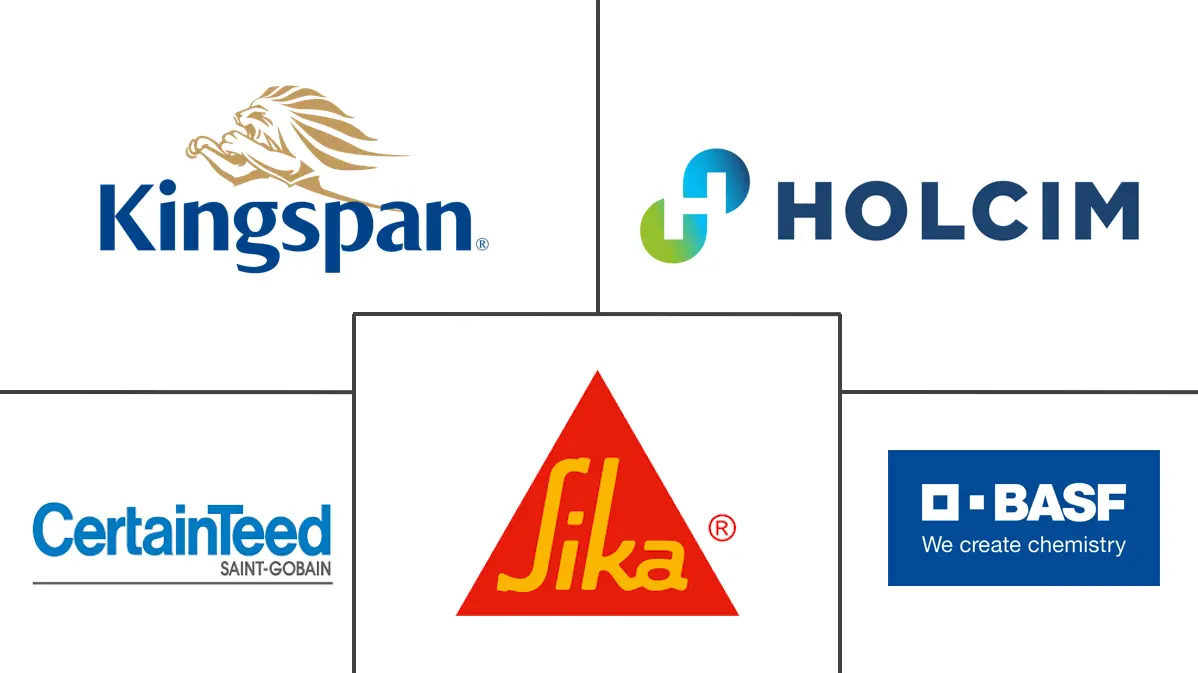
*Disclaimer: Major Players sorted in no particular order |
Green Building Materials Market Analysis
The Green Building Materials Market size is estimated at USD 272.05 billion in 2024, and is expected to reach USD 432.79 billion by 2029, growing at a CAGR of 9.73% during the forecast period (2024-2029).
The outbreak of COVID-19 in 2020 and the first half of 2021 significantly affected the global construction sector due to government-imposed bans and restrictions, thereby limiting the growth of the green building materials market. Residential real estate was the worst hit as strict lockdown measures across major cities resulted in the suspension of home registrations and slow disbursements of home loans. However, the sector has been recovering well since these restrictions were lifted. An increase in house sales, new project launches, and an increasing demand for new offices and commercial spaces have been leading the market recovery over the last two years.
- Over the medium term, the potential application of green building materials in energy-efficient buildings is the major driving factor driving the growth of the market studied. Furthermore, there are favorable government policies that support green building construction and ensure standard practices across all construction sectors. These policies are prompting the manufacturers of construction materials to include more green material compositions/systems in their products.
- On the flip side, the high first capital investments for green building construction when compared to conventional buildings is the key factor anticipated to restrain the growth of the market studied over the forecast period.
- Nevertheless, the increasing focus of various economies on achieving carbon neutrality, the declining operation costs of green buildings over time, and the growing trends in recycled construction are likely to create lucrative growth opportunities for the global market soon.
- North America is expected to dominate the market during the forecast period. This dominance is attributed to the high demand for framing, roofing, insulation, and various other applications in the residential, commercial, industrial, and infrastructure sectors.
Green Building Materials Market Trends
This section covers the major market trends shaping the Green Building Materials Market according to our research experts:
Increasing Consumption of Green Building Materials in the Residential End-use Industry
- The residential industry is the major end-user industry for green building materials. Various types of green building materials are gaining popularity in residential buildings owing to the increasing preference for materials that are energy-efficient, moisture-resistant, durable, and easy to maintain. Factors like personal safety, increasing awareness and affinity toward green building materials, and government regulations favor the continuous increase in the use of green building materials for residential applications.
- Fiber cement siding, thermally modified wood, bamboo, fly ash or ashcrete, hempcrete, and recycled plastic are some green construction materials that are witnessing increased adoption in the residential construction industry. Other natural materials, like cellulose, hemp, and cork, are used for insulation applications.
- Natural fibers such as cotton, jute, and wool, recycled materials such as terrazzo, and recycled concrete, stucco, stone, and rubber-based materials are also among the green building materials employed in various applications in the residential sector.
- The governments of various countries are providing green housing incentives to promote the construction of green residential projects. For instance, tax credits in the United States and Spain, the Green Mark incentive program in Singapore, and subsidies in New Zealand are promoting the construction of green residential buildings in the country, which is likely to favor the market studied.
- Over the last year, Japan made significant strides in green building leadership and continues to expand its impressive Leadership in Energy and Environmental Design (LEED) portfolio. Japan has more than 268 projects participating in LEED, comprising approximately 29.5 million sq. ft.
- Also, the Kreditanstalt für Wiederaufbau (KfW) program in Germany provides low-interest loans and grants for construction and renovation projects that meet certification ratings beyond code performance.
- China is the world's largest construction market. The Chinese government prioritized the country's 13th Five Year Plan, which has schemes for green building initiatives. The country's national climate commitment calls for 50% of all new buildings constructed by 2020 to be certified green.
- India has around 6,548 registered green building projects. In June 2021, the IIA and the CII-IGBC signed an agreement to boost green building methods in the areas of architectural design and planning.
- Owing to all the above factors, the usage and demand of green building materials for residential construction applications are expected to grow during the forecast period.
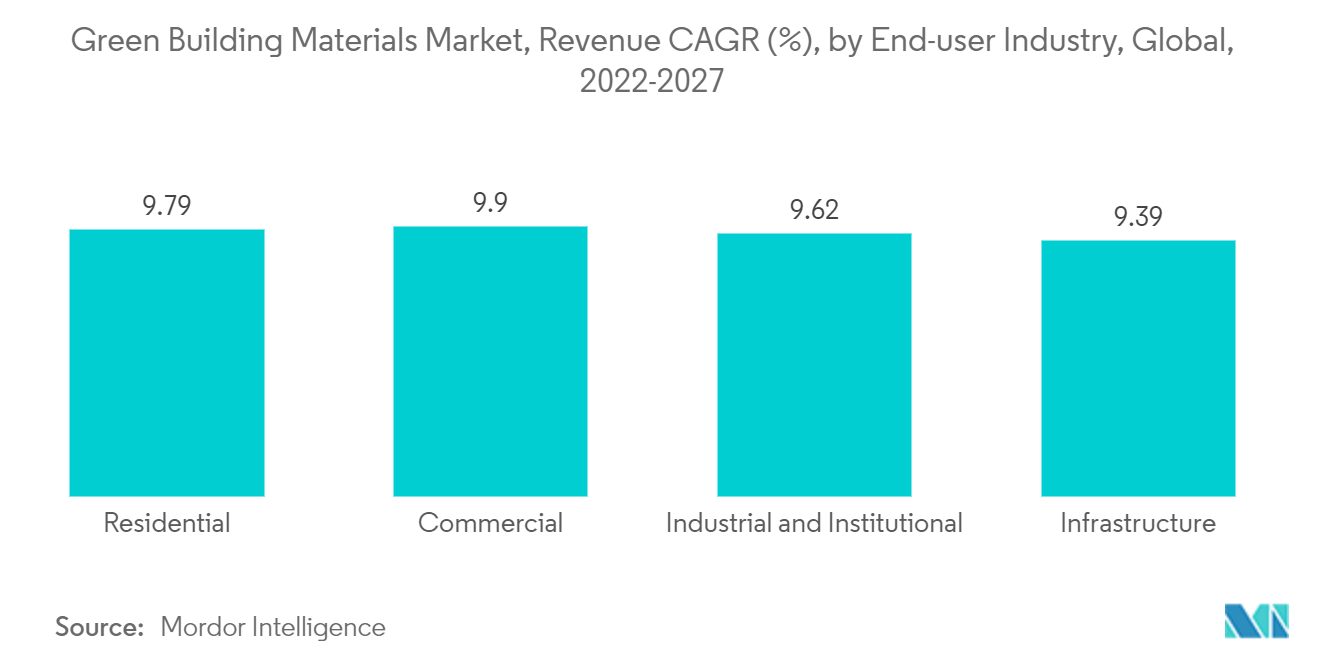
North America to Dominate the Market
- In North America, the high level of consumption of green building materials across all types of construction activities is the primary factor driving the growth of the green building materials market.
- The LEED rating system is the most widely used green building rating system in the United States. It provides a framework for healthy, efficient, carbon-saving, and cost-saving green buildings. LEED-certified buildings save money, improve efficiency, and lower carbon emissions.
- According to the USGBC, as of October 2022, the United States had around 20,125 Certified LEED projects, 21,068 Silver projects, 21,206 Gold projects, and 7,027 Platinum projects.
- According to the US Energy Information Administration, the energy consumption by the residential and commercial sectors in 2021 was rounded to 21 quadrillion Btu, which made up 28% of the country's end-use energy consumption. The high energy demand from buildings has drawn the attention of the US government, which has announced its plans to invest USD 3.16 billion to transform around 450,000 homes in low-income areas into energy-efficient structures and cut down on the country's utility bills.
- The Government of Canada has committed to reducing the country's total GHG emissions to 40-45% below 2005 levels by 2030 and to reach net zero by 2050 in order to protect the environment and reduce the impacts of climate change. To achieve such goals, the country's budget for 2022 committed CAD 150 million to develop the Canada Green Buildings Strategy. This strategy will mobilize national action to transform markets and reduce costs to meet this goal.
- According to the WGBC, the best-performing sector for green buildings in Canada is new institutional construction. Currently, over one-third of all new projects in the country are green, and this number is likely to grow significantly in the coming years. Environmental regulations and reduction in energy consumption are the factors driving the growth of the green building industry in Canada.
- According to the USGBC, in 2021, Mexico held the 10th position globally in terms of square feet (sq. ft) of LEED certification, with a value of 10,285,729.57 sq. ft in a total of 47 projects.
- Also, as of December 2021, two Mexican REITs, Fibra Macquarie and Fibra Shop, were in the process of certifying their entire portfolios green through a combination of retrofit investments and higher quality-on-entry standards. Privately-owned Mexican firms are also displaying their commitment to LEED and green building.
- All the above-mentioned factors are likely to fuel the growth of the North American green building materials market over the forecast period.
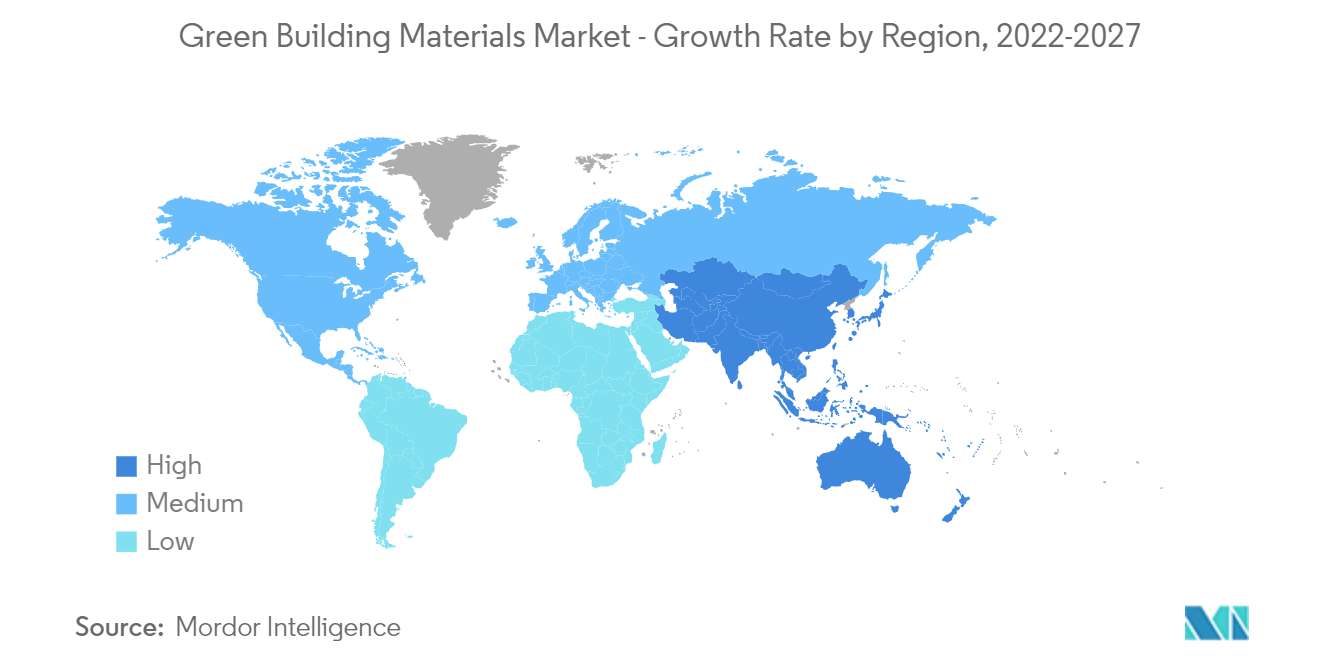
Green Building Materials Industry Overview
The global green building materials market is fragmented, with many players having small shares of the market. Some of the major companies (in no particular order) are Sika AG, Kingspan Group, Holcim, Saint-Gobain (CertainTeed), and BASF SE.
Green Building Materials Market Leaders
-
Sika AG
-
Kingspan Group
-
Holcim
-
Saint-Gobain (CertainTeed)
-
BASF SE
*Disclaimer: Major Players sorted in no particular order
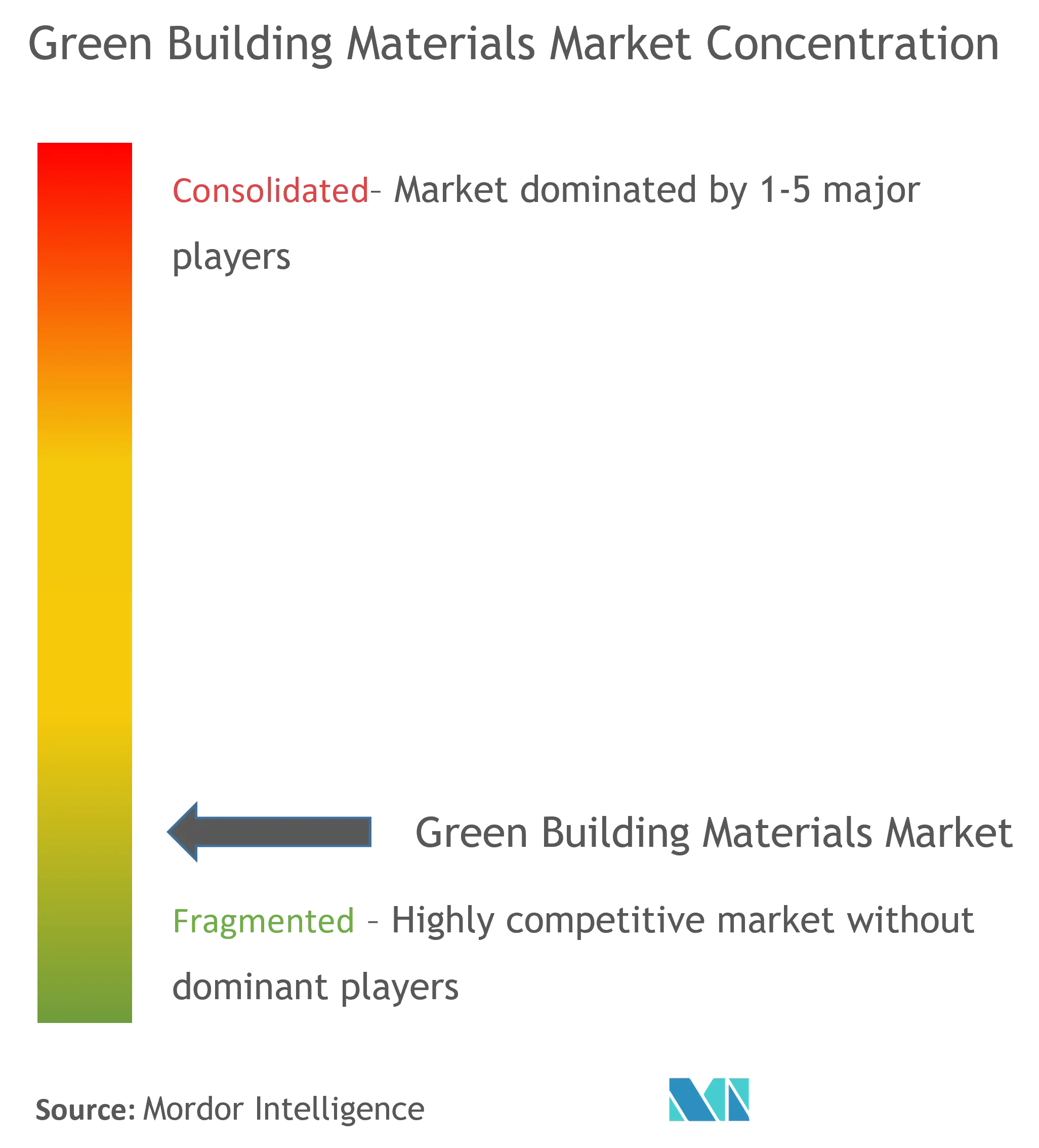
Green Building Materials Market News
- October 2022: Holcim acquired Wiltshire Heavy Building Materials, one of the leading companies providing building solutions and material circularity in the United Kingdom. This acquisition will strengthen Holcim's market presence in the United Kingdom's green building materials market.
- August 2022: Saint-Gobain acquired Kaycan, a manufacturer and distributor of exterior building materials in Canada and the United States. Saint-Gobain strengthened its global leadership in light and sustainable construction with this acquisition, becoming the leading player for sidings in Canada and expanding its vinyl offering across the United States with complementary solutions in aluminum and engineered wood.
- January 2022: Binderholz GmbH acquired the UK-based sawmill group, BSW Timber Ltd, which is a subsidiary of the Austrian Binderholz Group. BSW Timber Ltd produces more than 1.2 million cu. m of sawn timber per annum. This acquisition made Binderholz GmbH the largest sawmill and solid wood processing company in Europe.
Green Building Materials Market Report - Table of Contents
1. INTRODUCTION
- 1.1 Study Assumptions
- 1.2 Scope of the Study
2. RESEARCH METHODOLOGY
3. EXECUTIVE SUMMARY
4. MARKET DYNAMICS
-
4.1 Drivers
- 4.1.1 Increasing Demand for Insulation and Energy-efficient Buildings
- 4.1.2 Favorable Government Policies for Green Buildings
-
4.2 Restraints
- 4.2.1 High Initial Capital Investment Compared to Conventional Buildings
- 4.3 Industry Value-Chain Analysis
-
4.4 Porter's Five Forces Analysis
- 4.4.1 Bargaining Power of Suppliers
- 4.4.2 Bargaining Power of Buyers
- 4.4.3 Threat of New Entrants
- 4.4.4 Threat of Substitute Products and Services
- 4.4.5 Degree of Competition
5. MARKET SEGMENTATION (Market Size in Value)
-
5.1 Application
- 5.1.1 Framing
- 5.1.2 Insulation
- 5.1.3 Roofing
- 5.1.4 Exterior Siding
- 5.1.5 Interior Finishing
- 5.1.6 Other Applications
-
5.2 End-use Industry
- 5.2.1 Residential
- 5.2.2 Commercial
- 5.2.3 Industrial and Institutional
- 5.2.4 Infrastructure
-
5.3 Geography
- 5.3.1 Asia-Pacific
- 5.3.1.1 China
- 5.3.1.2 India
- 5.3.1.3 Japan
- 5.3.1.4 South Korea
- 5.3.1.5 Rest of Asia-Pacific
- 5.3.2 North America
- 5.3.2.1 United States
- 5.3.2.2 Canada
- 5.3.2.3 Mexico
- 5.3.3 Europe
- 5.3.3.1 Germany
- 5.3.3.2 United Kingdom
- 5.3.3.3 Italy
- 5.3.3.4 France
- 5.3.3.5 Rest of Europe
- 5.3.4 South America
- 5.3.4.1 Brazil
- 5.3.4.2 Argentina
- 5.3.4.3 Rest of South America
- 5.3.5 Middle East & Africa
- 5.3.5.1 Saudi Arabia
- 5.3.5.2 South Africa
- 5.3.5.3 Rest of Middle East & Africa
6. COMPETITIVE LANDSCAPE
- 6.1 Mergers and Acquisitions, Joint Ventures, Collaborations, and Agreements
- 6.2 Market Share (%)**/Ranking Analysis
- 6.3 Strategies Adopted by Leading Players
-
6.4 Company Profiles
- 6.4.1 BASF SE
- 6.4.2 Binderholz GmbH
- 6.4.3 Dupont
- 6.4.4 Holcim
- 6.4.5 Interface Inc.
- 6.4.6 Kingspan Group
- 6.4.7 Owens Corning
- 6.4.8 PPG Industries Inc.
- 6.4.9 Saint- Gobain (Certainteed)
- 6.4.10 Sika AG
- 6.4.11 Soben International (Asia-Pacific) Ltd
- *List Not Exhaustive
7. MARKET OPPORTUNITIES AND FUTURE TRENDS
- 7.1 Increasing Focus on Achieving Carbon Neutrality by Several Economies
- 7.2 Other Opportunities
Green Building Materials Industry Segmentation
Green building materials are defined as materials that are non-toxic, environment-friendly, and sustainable, leading to improved occupancy health, lowered energy cost, and reduced energy consumption. The operating costs of green buildings are lower than that of regular buildings, with 63% lower water usage and 53% lower electricity usage.
The green building materials market is segmented by application, end-user industry, and geography. By application, the market is segmented into framing, insulation roofing, exterior siding, interior finishing, and other applications. By end-user industry, the market is segmented into residential, commercial, industrial and institutional, and infrastructure. The report also covers the market size and forecasts for the green building materials market in 15 countries across major regions. For each segment, the market sizing and forecasts have been done based on revenue (USD million).
| Application | Framing | |
| Insulation | ||
| Roofing | ||
| Exterior Siding | ||
| Interior Finishing | ||
| Other Applications | ||
| End-use Industry | Residential | |
| Commercial | ||
| Industrial and Institutional | ||
| Infrastructure | ||
| Geography | Asia-Pacific | China |
| India | ||
| Japan | ||
| South Korea | ||
| Rest of Asia-Pacific | ||
| Geography | North America | United States |
| Canada | ||
| Mexico | ||
| Geography | Europe | Germany |
| United Kingdom | ||
| Italy | ||
| France | ||
| Rest of Europe | ||
| Geography | South America | Brazil |
| Argentina | ||
| Rest of South America | ||
| Geography | Middle East & Africa | Saudi Arabia |
| South Africa | ||
| Rest of Middle East & Africa |
Green Building Materials Market Research FAQs
How big is the Green Building Materials Market?
The Green Building Materials Market size is expected to reach USD 272.05 billion in 2024 and grow at a CAGR of 9.73% to reach USD 432.79 billion by 2029.
What is the current Green Building Materials Market size?
In 2024, the Green Building Materials Market size is expected to reach USD 272.05 billion.
Who are the key players in Green Building Materials Market?
Sika AG, Kingspan Group, Holcim, Saint-Gobain (CertainTeed) and BASF SE are the major companies operating in the Green Building Materials Market.
Which is the fastest growing region in Green Building Materials Market?
Asia-Pacific is estimated to grow at the highest CAGR over the forecast period (2024-2029).
Which region has the biggest share in Green Building Materials Market?
In 2024, the North America accounts for the largest market share in Green Building Materials Market.
What years does this Green Building Materials Market cover, and what was the market size in 2023?
In 2023, the Green Building Materials Market size was estimated at USD 247.93 billion. The report covers the Green Building Materials Market historical market size for years: 2019, 2020, 2021, 2022 and 2023. The report also forecasts the Green Building Materials Market size for years: 2024, 2025, 2026, 2027, 2028 and 2029.
What are the emerging trends in the Green Building Materials Market?
The emerging trends in the Green Building Materials Market are a) Development of innovative sustainable materials b) Integration of smart technologies into green buildings c) Adoption of circular economy principles in construction d) Use of prefabricated and modular construction methods e) Growing demand for biodegradable and bio-based materials
Green Building Materials Industry Report
The global green building materials market is experiencing significant growth, driven by increasing environmental awareness and the rising demand for sustainable construction practices. These materials, including wood, bamboo, and recycled plastic, are favored for their energy efficiency and minimal environmental impact from production to disposal. Market segments like roofing and insulation are seeing substantial growth due to their energy-saving properties and the growing adoption of green roofing solutions. The market is segmented by end-use industries, with the residential sector leading due to heightened consumer awareness and supportive government policies promoting energy-efficient constructions. Non-residential sectors are also adopting green materials to comply with sustainability goals and reduce operational costs. Overall, the market is driven by regulatory support, growing consumer awareness, and the economic viability of green building materials, making them a crucial component in the drive towards more sustainable building practices globally. This trend is reflected in the expanding market size and the strategic positioning of companies to capitalize on these opportunities. For detailed statistics and a market forecast, refer to Mordor Intelligence™ Industry Reports, which offer a comprehensive analysis and free report PDF download.



